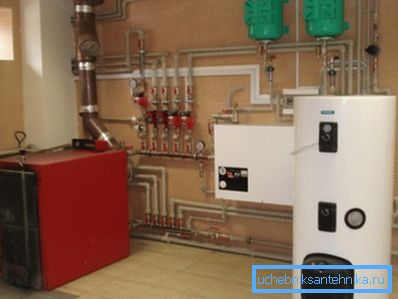Gas heating boilers for a private house - the subtleties of
In those places where there is a centralized gas supply, gas boilers for home heating are the most popular way to heat a home. The reason for this is one, they are economical. Solid fuel, although not much more expensive, requires separate storage space.
As for electricity, even for buildings with an average square, the cost of heating will be many times more.

At the moment, the market offers many models of such equipment and, choosing a gas boiler for home heating, it is easy to get confused. On an unprepared person, a lot of unclear terms and narrow-profile information immediately pour out.
It turns out that the equipment can be single and double-circuit, condensing and convection, there are many control systems, plus there are also mounted and floor-standing boilers for heating a private house.
As you know, there are practically no universal solutions in nature, so in this case you need to push off from a specific object, its square, degree of insulation and the needs of your family. We, in turn, will try to clarify what should be paid attention to.
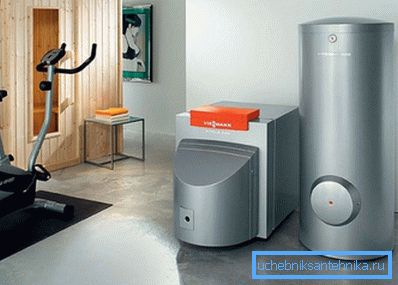
How it works
The very general principle of operation of any heating equipment of this kind is simple and clear. The fuel enters the combustion chamber and heats the liquid energy carrier. Subsequently, the liquid energy carrier or simply hot water enters the piping system and heats the home, but there are nuances.
Single or dual circuit unit
Naturally, both single-circuit and double-circuit gas heating boilers for the home are designed to heat water, but the difference between them is significant.

- Devices equipped with 1 circuit, as a rule, have a closed system and are used exclusively for heating the house. They consume significantly less fuel, since energy is spent only on maintaining a certain temperature in radiators and piping. If the owners want to get more and hot water in the tap, then an indirectly heated boiler tank is mounted, but the power of such a system is not great.
- Dual-circuit gas boilers for the house have much more features. They have a more convenient management system and higher performance. As the name implies, they have 2 circuits, one of which works for heating a dwelling, and the other provides households with hot water. For an average one or two-story house with 1 bathroom, this unit is quite enough, but for several bathrooms, it is necessary to connect the boiler.
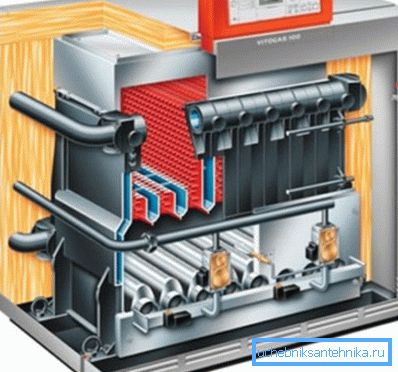
Install on the floor or buy a wall mounted unit
Here, the choice is yours:
- Wall-mounted gas boilers for the house have a relatively low weight, which makes suspension possible. They can be single or dual circuit, but the total power here is not great. They are perfect for a small dwelling with a small square in which a family of up to 4 people lives.
- Floor gas boilers for heating a private house are used in rooms with medium and large square. Without an additional boiler, they can heat up to 200m ?, plus fully provide people with hot water. For such devices, as a rule, a separate, small room is allocated.
Tip: if you equip a boiler room or there may be interruptions in fuel, it makes sense to purchase combined heating boilers for solid fuel and gas, the price is not much higher, but there is an alternative.

Condensation or covector
Convector heating gas boiler for the house is the last century. It has not a perfect combustion chamber, which causes considerable heat loss. Such devices have less weight and more affordable price, but then the fuel will consume more and eventually cost more.
Condensation gas boilers for home heating have an efficiency close to 100%. They appeared relatively recently and immediately gained popularity. It is caused by the fact that they use more energy of water vapor.
Such devices are equipped with additional heat exchangers and an improved energy removal system, so they are more profitable in the long term.
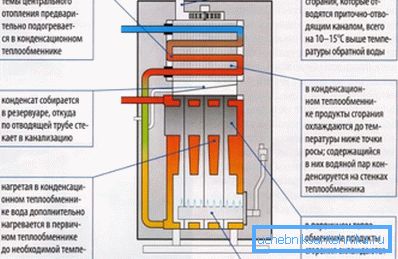
Power calculation
If you decide to buy a gas heating boiler for the house, then the first thing to start with is to figure out with your own hands how much power you need. The instruction here is elementary, initially it is considered that for heating every 10m? the area of the house with standard ceilings up to 3m, is spent 1 kW.
It is necessary to divide the total square of your home by 10, then round up the data in a big way. Next, increase the data by a quarter of 25% and with this result, you can study the catalogs.
In some cases, when the house is poorly insulated, it makes sense to increase the design value of power by another quarter.
- The unit up to 15 kW has a capacity of 12 liters per minute, it is able to provide two-room building and a family of 2 people with heat and hot water.
- Devices of 20-25 kW already produce 15 liters per minute and heat up to 100m ?. They can arrange a full-fledged family of 4 people.
- Gas heating boiler for a house with a capacity of 35-40 kW produces 20 liters per minute and heats up to 200m ?. To increase the volume you need to install additional boilers.
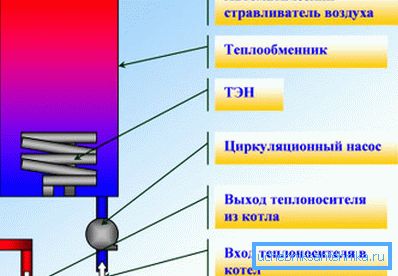
Experts do not advise taking too powerful a device with a large margin for a small room. This is just as bad as using a low-power overload unit. The power reserve will lead to the fact that the boiler will operate in a pulsed mode and quickly fail.
Important: some gas boilers for home heating in the accompanying documents immediately contain information about the exact number of square meters that the unit is able to heat. Do not completely trust these figures, as they can be calculated for a different climate zone.
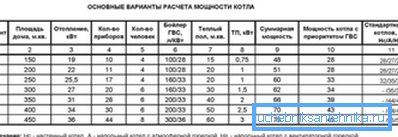
Heat exchanger selection
Immediately it should be noted that open-type heat exchangers use oxygen taken from the room, so we advise them to immediately abandon. In closed heat exchangers, both the air flow and the discharge of gases are carried out by force through a coaxial pipe.

As for the material, the most common are stainless steel and cast iron. The products of cast iron have a large heat capacity and service life. Nodes from stainless steel are considered more perfect and technological.
Often, cast iron is used in floor systems, and stainless steel in the mounted.
Tip: sometimes in “very economy” units you can find heat exchangers made of ordinary steel, their resource is small and the only advantage is the price.
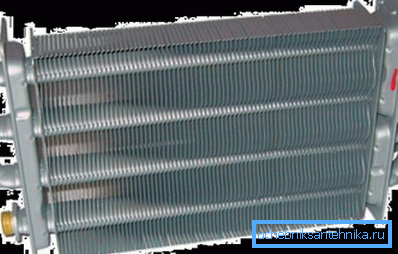
So what to buy
Analyzing all the above, we can formulate a few general tips.
- First of all, the gas heating boiler for the house should be designed specifically for this building, no need to take too powerful.
- The heat exchanger from a stainless steel or from cast iron.
- Automation must have the minimum necessary protection. From the burner attenuation, from the leakage of water or gas, from interruptions in the chimney and from excessive overheating of the liquid at the outlet.
- The pipes inside the unit must be stainless steel or bronze.
- If hot water is needed for domestic needs, you should take a dual-circuit apparatus.
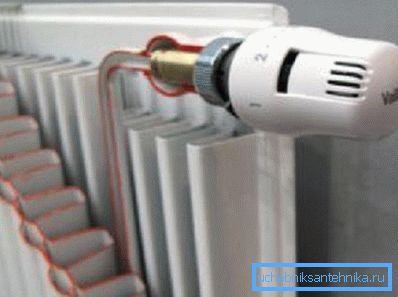
The video has additional information on the choice of gas equipment.
Conclusion
In conclusion, I want to say a few words about management systems. Undoubtedly, the programmable modern equipment on the remote control is prestigious and convenient. But there is a time-tested law, the more complex the unit, the higher the likelihood of its sudden failure.
